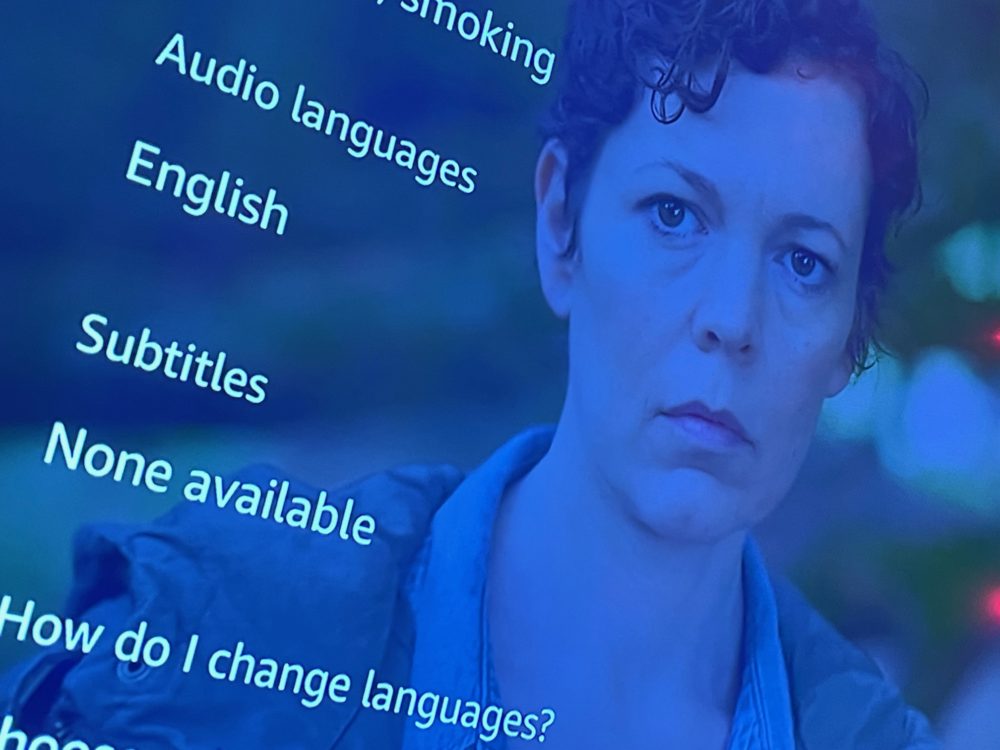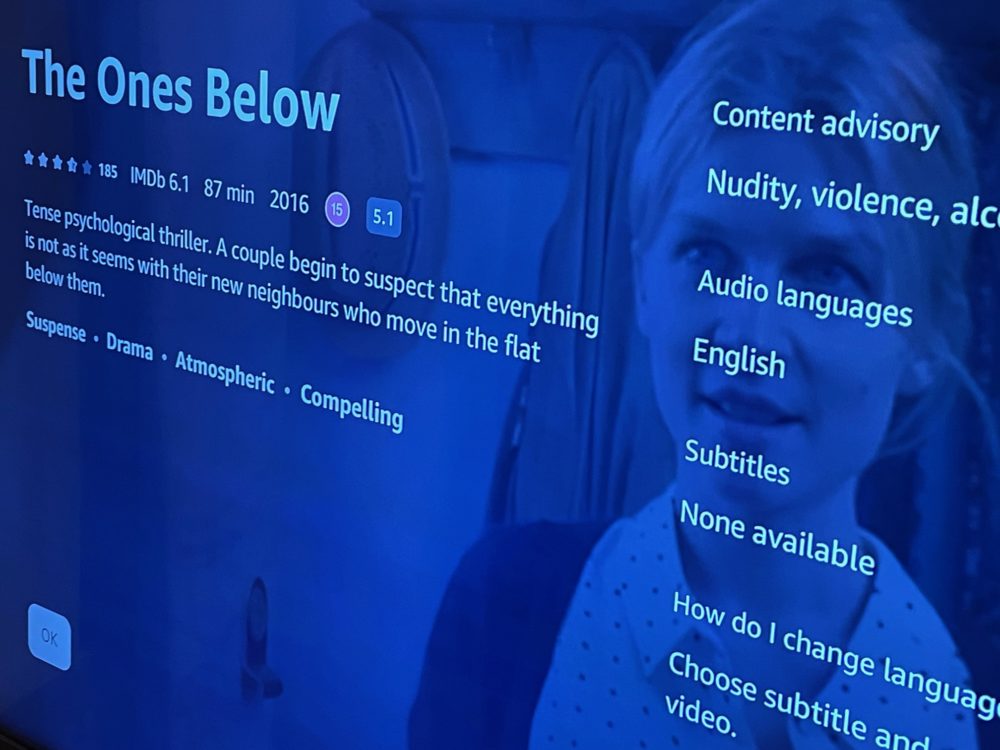Amazon Prime – subtitles should be a right, not a luxury

Stephen Price
Like many people who should wear their hearing aids, my mum never could quite get on with them.
Her father was stone deaf, and the older she became, the greater her need to wear hearing aids became.
“It’s not the volume – it’s the clarity,” she’d say, time and time again, despite evidently having an issue with both judging by the vibrating walls whenever the television would be on.
Her job, or calling if you will, as a Presbyterian minister, led to many an event (and excuse for a spread), and my sister and I would often tag along.
One thing we’d encounter while doing anything in her company, however, was the often hilarious and downright bizarre responses she’d offer while conversing with people – mostly, but not exclusively, without her hearing aids in.
Pick a reply, any reply!
Her technique seemed to be something along the lines of, ‘I think they said this, let’s just say something random back, it’s bound to work!’
God bless the good Christian folk, it was only ever my sister and I that would call her out on it, and we’d often act as a form of raised-volume interpreter for her if we were ever nearby to avoid another unintentional Ronnie Barker-esque performance.
Fast forward a few years, and I find myself doing the same thing, only with no trusty interpreter by my side.
Differing from my mum’s, my go-to technique is: Ask two times max for them to repeat, then plump for an appropriate faux-laugh, ‘awww’ or an ‘oh right’ in response rather than ask a third time.
For anyone out there that I may have laughed at when I should have offered an ‘I’m so sorry to hear that – it really wasn’t their time to go’, then I wholeheartedly apologise.
Dog walks usually end up with a return home thinking ‘What did I just say, and what did they say for that matter?’ after conversations at-a-distance with barking dogs betwixt.
Like Welsh learner and speaker lanyards and pin badges (that are excellent conversation starters!), there are plenty of hard of hearing ones available for anyone else in a similar situation.
I have yet to arrange that all-important hearing test. But I will. One day.
Empathy
My descent into fully-fledged not-very-good-at-hearing has seen me develop many a workaround, and I’ve also developed a much better understanding of my mum’s exasperation at the fact that it’s not the bloody volume, it’s the clarity.

One of my trusty workarounds that has become an absolute necessity, is using subtitles when watching the television.
Without, I’m completely lost with most things ‘on the box’, or even on my phone for that matter.
I’ve taken for granted how good most ‘British’ TV is when it comes to subtitles – and also give a huge amount of credit to S4C for their superb content and subtitling in both Welsh and English.
Inclusivity
Inclusivity seems to be at the forefront of the minds of creators of TV this side of the Atlantic (in spite of a raft of complaints about the clarity of recent BBC productions), and generally I’ve found Netflix to be pretty decent in that department (decent in subtitling not its US-heavy content quality, might I add).
There are, sadly one too many channels that are completely unwatchable for me (‘Great! Movies’ et. al.) with their zero-effort attempts at providing subtitles. Or perhaps it’s finance related. Either way, I’m left out.
And it’s not just the hard of hearing that use subtitles.
Indeed, studies have shown that young people are four times as likely to use subtitles while watching the television, more often than not for deeper comprehension in a world of multiple devices and social media platforms competing for attention.
The ‘extra concentration level’ is only one reason, however – with modern families sitting together in the same room while enjoying different screens, with one or more of them muted and captioned/subtitled.
Amazon Prime
What has surprised me most, however, is the surprising number of mainstream productions with no subtitles on Amazon Prime – a streaming platform used by over 13 million UK households.
Admittedly, I’m not Amazon’s biggest fan, but I’ve found myself watching a lot more television with my elderly dad lately – often while he’s hooked up to an oxygen machine, with television one of his few remaining distractions from the daily tolls of a terminal lung disease.
Sadly, my snoring dogs, my kaput hearing, my absent-mindedness, my mobile phone and the questionable clarity of anything that has competing sounds (music, background noise, irregular volume etc.) and my dad’s essential medical kit mean that, yet again, I’m back to asking myself ‘what did they just say? And what is going on?’
Alas, I’ve tried and failed, and tried again with Prime over the last few months, but the amount of content without any subtitles whatsoever has outweighed those with, that I give up.
But why should I?
Over the past few weeks, I’ve ‘watched’ (and not always heard) twelve films on Prime, with only three successful experiences with subtitles, (Black Bear, Saltburn and Our Friend), while there were nine that I battled through with no subtitles, namely All Good Things, The Thirteenth Tale, American Woman, Shell, Lapsis, Go with Me, The Ones Below, Under Suspicion and One Point 0.
Until recently, I’ve just come to accept it.
Ah, that’s how it is. My dog snores, my hearing’s rubbish, the soundtrack was a bit loud… But why should I, or why should anyone for that matter, accept the lack of something so basic. And something we are paying for.
And, while I can muddle on, there are countless others out there with much worse hearing than I have, or absolutely no hearing at all, that Amazon are happy to take funds from.
It’s not just unfair, it’s discriminatory and, in many cases, downright cruel.
Reliance
According to the RNID, 12 million adults in the UK are deaf, have hearing loss or tinnitus. That is roughly 10.1 million people in England, 1 million people in Scotland, 610,000 people in Wales and 320,000 people in Northern Ireland.
And I’m not one of those statistics.
So for the estimated 610,000 people here in Wales that subtitles are not just a ‘would like to have’, there are many others that, like me, have come to rely upon subtitles just to be able to fully enjoy and fully immerse themselves in a TV or film production.
As it stands, Amazon is denying deaf people the ability to watch the television alone or with their loved ones.
Sharing my frustrations, Prime customers have taken to uk.amazonforum.com (over the years!!!) to try to get Amazon to listen to their complaints, invariably being met with an AI-esque response giving them instructions on how to enable subtitles on their TV.
Great advice when there are so often none.
‘It’s not us. It’s you.’
In response to this article, a spokesperson from Amazon provided the following information:
Prime Video’s Accessibility Commitment:
- At Prime Video, we are committed to building an inclusive, equitable, and enjoyable streaming experience for all our customers.
- Our teams work towards this by continuously improving the availability of closed captions and subtitles for customers who are deaf and hard of hearing, and audio descriptions for blind and visually impaired customers.
- Today, Prime Video offers captioning and subtitling in 30 languages, and audio descriptions in 12 languages.
- We are committed to making audio descriptions as commonly available as captions are today.
About Prime Video Accessibility Features:
- Customizing Subtitles & Captions – On select living room devices and web, customers have the option to increase text size, as well as change the font color and background color for subtitles and captions.
- Dialogue Boost – Dialogue Boost allows customers to increase the volume of dialogue relative to background music and effects. The feature will roll out on additional titles this year.
- Closed Captions – Customers can enable Closed Captions (CC) during playback of a supported title on any device that offers the Prime Video experience.
- Audio Descriptions – Customers can turn on Audio Descriptions during playback of a supported title on any device that offers the Prime Video experience. Prime Video has thousands of titles with Audio Descriptions and our catalog of audio described movies and series is constantly evolving.
- 100% of Amazon Originals are captioned/subtitled in the UK.
- The majority of our other UK titles (not Amazon Originals) are subtitled or captioned, and we are working to increase this share too over time
About Dialogue Boost:
- Dialogue Boost allows customers to increase the volume of dialogue relative to background music and effects, creating a more comfortable and accessible viewing experience.
- Prime Video is the first global streaming service to offer this feature.
- While Dialogue Boost was built with the needs of customers who are hard of hearing in mind, anyone can use the feature to suit their personal listening preferences.
- The feature is available across all devices that support the Prime Video experience and offers a capability that was previously only available to customers with high-end theater systems, specialized audio equipment, or select Smart TVs.
- Dialogue Boost is available globally on select Amazon Originals including Tom Clancy’s Jack Ryan, The Marvelous Mrs. Maisel, and Harlem, as well as movies including The Big Sick, Beautiful Boy, and Being the Ricardos. The feature will be available on additional titles this year.
About Device Accessibility
- At Amazon, we strive to be Earth’s most customer-centric company.
- In addition to Prime Video, our Device team is working hard to serve the needs of every customer, including those with disabilities.
- Working back from customers with disabilities, we want it to be easy for customers to enjoy everything Amazon has to offer.
- Fire TV, Amazon’s family of streaming media players that includes streaming sticks, TVs and more, also offers a number of accessibility features:
- VoiceView is a screen reader for customers for blind and low vision customers.
- Text Banner assists people with narrow field of vision by consolidating the UI’s written banner to make it easier to see.
- Closed Captioning is available on hundreds of thousands of titles.
- Alexa work pioneered how customers access and engage with our devices, including Alexa Captionsand Tap to Alexa.
- On Fire TV, Alexa helps customers navigate the experience with playback control and voice search.
Support our Nation today
For the price of a cup of coffee a month you can help us create an independent, not-for-profit, national news service for the people of Wales, by the people of Wales.





Being partially deaf and having to wear hearing aids myself I know just how hard it is to comprehend some of the speech on certain programmes. I wear headphones but still have to put subtitles on as people ‘seem’ to mumble – the clarity terrible. It can be funny sometimes though when there is a dubbed film and the subtitles don’t match some of the speech. I’m not looking for sympathy though, when people say – awe you where hearing aids – I say, at least I can turn my hearing down, can you? 😎
I’ve been having a go at Amazon for ages over subtitling and got absolutely nowhere despite how customer-centric Amazon claims to be 🙁 My partner is German and I have hearing difficulties. My 92 year old mother has even worse hearing as does my brother. We are all having to put up with Amazon’s patchy approach to subtitling which, as you stated, even includes major films and series that are not subtitled. Even old films from 30 years ago get listed with no subtitles. You don’t get this rubbish on Netflix and Amazon really should be ashamed of themselves and… Read more »